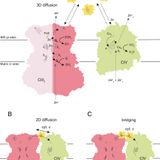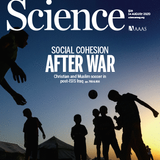RECENT ARTICLES

Cryo-EM structure and kinetics reveal electron transfer by 2D diffusion of cytochrome c in the yeast III-IV respiratory supercomplex
Edited by Yifan Cheng, University of California, San Francisco, CA, and approved January 19, 2021 (received for review October 11, 2020)In the last steps of food oxidation in living organisms, electrons are transferred to oxygen through the membrane-bound respiratory chain. This electron transfer is mediated by mobile carriers, such as membrane-bound quinone and water-soluble cytochrome c. The latter transfers electrons from respiratory complex III to complex IV. In yeast, these complexes assemble into III2IV1/2 supercomplexes, but its role has remained enigmatic. This study establishes a...…Edited by Yifan Cheng, University of California, San Francisco, CA, and approved January 19, 2021 (received for review October 11, 2020)In the last steps of food oxidation in living organisms, electrons are transferred to oxygen through the membrane-bound respiratory chain. This electron transfer is mediated by mobile carriers, such as membrane-bound quinone and water-soluble cytochrome c. The latter transfers electrons from respiratory complex III to complex IV. In yeast, these complexes assemble into III2IV1/2 supercomplexes, but its role has remained enigmatic. This study establishes a...WW…

A mathematical model reveals the influence of population heterogeneity on herd immunity to SARS-CoV-2
In response to severe acute respiratory syndrome coronavirus 2 (SARS-CoV-2), some politicians have been keen to exploit the idea of achieving herd immunity. Countering this possibility are estimates derived from work on historical vaccination studies, which suggest that herd immunity may only be achieved at an unacceptable cost of lives. Because human populations are far from homogeneous, Britton et al. show that by introducing age and activity heterogeneities into population models for SARS-CoV-2, herd immunity can be achieved at a population-wide infection rate of ∼40%, considerably lower...…In response to severe acute respiratory syndrome coronavirus 2 (SARS-CoV-2), some politicians have been keen to exploit the idea of achieving herd immunity. Countering this possibility are estimates derived from work on historical vaccination studies, which suggest that herd immunity may only be achieved at an unacceptable cost of lives. Because human populations are far from homogeneous, Britton et al. show that by introducing age and activity heterogeneities into population models for SARS-CoV-2, herd immunity can be achieved at a population-wide infection rate of ∼40%, considerably lower...WW…
- Total 2 items
- 1